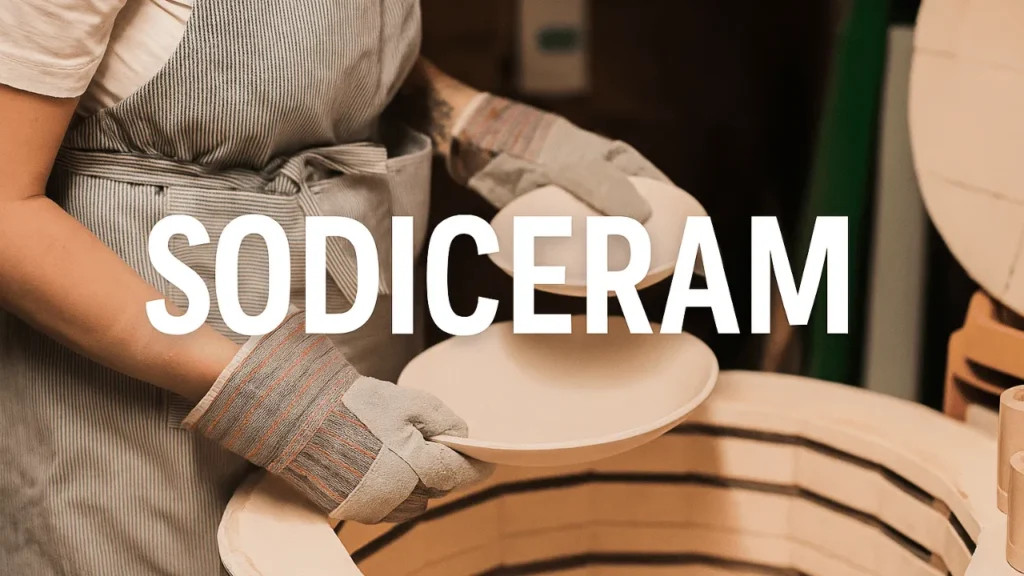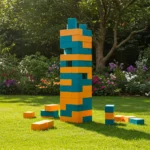In the ever-evolving landscape of interior design and architecture, where aesthetics meet environmental responsibility, Sodiceram emerges as a beacon of innovation—a revolutionary ceramic material that fuses sodium-based compounds with cutting-edge engineering to deliver unparalleled durability and style. Picture this: sleek kitchen counters that shimmer under morning light, resilient bathroom walls that defy humidity’s grasp, or outdoor terraces that weather storms with graceful poise, all while slashing your carbon footprint. Sodiceram isn’t merely a product; it’s a paradigm shift, transforming how we envision sustainable living spaces that don’t compromise on glamour.
Crafted through precise mineral blending and eco-optimized firing processes, this high-performance ceramic boasts reduced porosity, superior thermal insulation, and a lifecycle that redefines longevity, making it the darling of green architects and style-savvy homeowners alike. As global mandates push for recycled content in building materials—think the EU’s 2030 targets for 20-30% reuse—Sodiceram steps up with its waste-repurposing prowess, turning industrial byproducts into breathtaking surfaces that elevate everyday environments. Whether you’re revamping a cozy urban loft or designing a sprawling eco-retreat, embracing Sodiceram solutions means weaving sustainability into the fabric of your design dreams, where every tile tells a story of resilience, beauty, and a brighter planetary future. Dive into this guide to uncover why Sodiceram is the eco-chic secret savvy designers swear by, and how it can infuse your projects with that perfect blend of form, function, and forward-thinking flair.
The Essence of Sodiceram: A Fusion of Science and Sustainability
At its core, Sodiceram represents a masterful alchemy of tradition and technology, where age-old ceramic artistry collides with modern sodium-infused formulations to birth a material that’s as tough as it is tantalizing. Unlike conventional ceramics that often falter under moisture or mechanical stress, Sodiceram’s sodium-based additives create a denser molecular structure, slashing water absorption rates to under 0.5% and boosting flexural strength by up to 40%, according to recent industry benchmarks from materials labs. This isn’t just lab jargon—it’s real-world wizardry that translates to floors and facades that laugh off spills, scratches, and seasonal swings, all while maintaining a velvety matte or glossy finish that rivals natural stone.
What truly sets Sodiceram apart in the eco-chic arena is its commitment to circularity: produced with up to 25% recycled industrial waste, it minimizes mining impacts and energy demands during firing, which runs 15-20% cooler than standard kilns, thereby curbing CO2 emissions without skimping on quality. Imagine sourcing tiles that not only mimic the veined elegance of marble or the rustic warmth of terracotta but also carry green certifications like LEED credits, appealing to eco-conscious clients who prioritize planetary health alongside Pinterest-perfect palettes. From subtle neutrals that ground minimalist spaces to bold geometrics that pop in statement walls, Sodiceram’s palette empowers designers to craft narratives of harmony between human habitats and the earth. As urban density rises and sustainability becomes non-negotiable, Sodiceram solutions aren’t just viable—they’re visionary, inviting creators to build legacies that endure both aesthetically and ethically, one resilient layer at a time.
Eco-Chic Applications: Where Sodiceram Shines in Everyday Elegance
Versatility is the hallmark of Sodiceram, a material that slips seamlessly into the nooks and crannies of modern life, turning functional spaces into showcases of sustainable sophistication. In residential realms, it’s a game-changer for high-traffic zones like kitchens and entryways, where its slip-resistant surfaces—certified to R10 ratings—provide safe footing amid family frolics, while antimicrobial properties woven into the glaze keep bacteria at bay for healthier homes. Envision a sun-drenched backsplash in a chef’s dream galley, its iridescent hues catching steam and stories alike, or a spa-like vanity that weathers wet wipes and whims without a whisper of wear. Beyond the hearth, Sodiceram conquers commercial frontiers: think boutique hotel lobbies with intricate mosaic floors that draw eyes and footfall, or office break rooms clad in vibrant panels that infuse energy without overwhelming acoustics, thanks to its subtle sound-dampening qualities.
Outdoor enthusiasts rejoice, too—its UV-stable compositions ensure patios and pool surrounds retain their luster through relentless rays and rain, outlasting faux alternatives that fade faster than summer tans. For architects tackling green builds, Sodiceram’s thermal mass helps regulate indoor climates, potentially trimming HVAC bills by 10-15% in passive house designs, blending beauty with budgetary brilliance. And let’s not overlook the bespoke allure: custom large-format slabs up to 160×320 cm allow for seamless installations that minimize grout lines, creating illusions of infinite expanse in compact condos or grand galleries. By integrating Sodiceram solutions into your palette, you’re not just decorating—you’re directing a symphony of style and stewardship, where every application amplifies the eco-chic ethos and turns heads toward tomorrow’s trends today.
Durability Decoded: Why Sodiceram Outpaces the Ordinary
When it comes to standing the test of time, Sodiceram doesn’t just compete—it conquers, arming designers with a ceramic shield that’s engineered for endurance in an era of fleeting fads. Delve into its specs, and you’ll find a PEI rating of 4-5 for abrasion resistance, meaning it shrugs off the daily grind of heels, paws, and hurried steps like a pro athlete dodging defenders. Frost-proof to -20°C and heat-tolerant up to 120°C, it’s the ultimate all-season ally for climates that swing from sweltering to shivery, preventing cracks that plague lesser laminates.
Chemical resilience? Absolutely—spills from vino to vinegar bead off its non-porous shield, safeguarding against stains in labs, laundries, or lively dinner parties. Maintenance is a breeze, too: a simple sweep and mild soap suds restore its radiance, sans harsh scrubbers that etch away at imitators, ensuring your investment gleams for decades, backed by warranties stretching 25 years or more. Compared to porcelain peers, Sodiceram’s lighter weight—20% less dense—eases transport and installation, slashing labor costs without sacrificing solidity, while its low-VOC emissions during curing keep air pure from day one. In seismic zones, its flexibility absorbs micro-vibrations better than brittle basalt, adding a layer of safety to stylish statements.
For the eco-auditors among us, lifecycle analyses reveal Sodiceram’s embodied carbon is 30% lower than quarried quartzites, thanks to efficient production that recycles water and heat. This isn’t hyperbole; it’s hard data from ISO-compliant tests that position Sodiceram as the durable darling for discerning projects, where longevity isn’t a luxury—it’s the legacy of smart, sustainable choices that pay dividends in peace of mind and pristine appearances.
Green Credentials: Sodiceram’s Pledge to a Planet-Friendly Palette
Sustainability isn’t a buzzword for Sodiceram—it’s the blueprint, etched into every formula and firing cycle to forge a material that nurtures both beauty and the biosphere. By harnessing sodium silicates derived from abundant, low-impact sources, production sidesteps rare-earth mining, conserving resources while yielding ceramics that are 100% recyclable at end-of-life, looping back into new batches with zero quality dip.
Energy efficiency shines through in its kiln tech, which captures exhaust heat for reuse, docking fossil fuel reliance by a quarter and aligning with net-zero goals that savvy builders chase for certifications like BREEAM or WELL. Water-wise wonders abound: closed-loop systems in manufacturing reclaim 95% of process fluids, quenching thirst in drought-prone regions without depleting aquifers. For end-users, Sodiceram’s longevity curtails replacements, staving off landfill contributions— a single slab’s 50-year span averts tons of waste over rivals’ shorter sprints.
Biodiversity buffs will love how its sourcing avoids deforestation hotspots, partnering with certified quarries that regenerate habitats, while the material’s inert composition ensures no toxic leachates into soil or streams. In urban renewal projects, it scores high on embodied energy audits, often earning rebates under green building incentives like California’s Title 24. Pair this with traceable supply chains via blockchain-verified origins, and you’ve got transparency that thrills ethical consumers scrolling for substance behind the shine. Sodiceram solutions aren’t greenwashing—they’re genuine guardians, empowering eco-chic visions that harmonize human ingenuity with earth’s irreplaceable gifts, proving that true splendor sprouts from roots of responsibility.
Designer’s Delight: Styling Tips to Unleash Sodiceram’s Magic
Unlocking Sodiceram’s full potential demands a dash of daring and a dollop of discernment, turning tiles into tapestries that tantalize the senses and soothe the soul. Start with scale: opt for oversized formats in open-plan living areas to elongate sightlines, creating a fluid flow that blurs boundaries between zones, enhanced by underfloor heating compatibility for toasty transitions. Mix textures for intrigue—pair its smooth planes with rough-hewn wood or plush textiles, crafting tactile dialogues that invite touch and conversation.
Color courage pays off: earth-toned Sodiceram grounds boho vibes, while metallics amp industrial edge, always testing samples under your space’s lighting to capture true tones. For accents, embed LED strips beneath translucent variants for ethereal glows in powder rooms, or laser-etch patterns for personalized motifs that whisper whimsy. Budget wisely by zoning high-impact areas like islands or hearths, where Sodiceram’s splash-proof perks shine, extending to verticals for cohesive cohesion. Collaborate with pros for seamless seams using epoxy grouts in matching sheens, minimizing visuals while maximizing might. Seasonal swaps? Layer removable rugs over floors for festive flair without farewell to favorites. These tips transform Sodiceram from surface to statement, fueling designs that dazzle daily and delight eternally.
FAQs
What exactly is Sodiceram, and how does it differ from traditional ceramics?
Sodiceram is an advanced ceramic enhanced with sodium-based compounds for superior strength and lower porosity, outshining standard ceramics in durability and eco-friendliness for modern applications.
Is Sodiceram suitable for both indoor and outdoor use?
Yes, its frost-proof and UV-resistant properties make Sodiceram ideal for kitchens, bathrooms, patios, and facades, ensuring lasting performance in diverse environments.
How does Sodiceram contribute to sustainable building practices?
By incorporating 25% recycled waste and reducing firing energy by 20%, Sodiceram lowers carbon emissions and qualifies for green certifications like LEED, promoting circular design.
What are the maintenance requirements for Sodiceram surfaces?
Simple: sweep regularly and clean with mild soap; its non-porous nature resists stains, requiring no sealants and minimal effort for a pristine look over decades.
Where can I source Sodiceram products for my design project?
Available through specialty suppliers like BuiltUp Home or AMF CO, with options for custom orders; check for eco-bundles and installation guides to streamline your eco-chic vision.
Conclusion
Sodiceram redefines eco-chic design, blending durability, style, and sustainability into every stunning surface. From vibrant kitchens to resilient terraces, it empowers timeless elegance with a planet-friendly promise. Embrace Sodiceram solutions to craft spaces that inspire, endure, and elevate your sustainable design dreams.


